Danish-Polish Environmental Co-operation 1991-2000
Chapter 8Air pollution - a threat to the environment and the public health
Waste
water treatment and gypsum handling at Dolna Odra Power Plant
Exploitation of Geothermal
Energy
Air pollution is not only a threat to your health. It is also a serious threat to the environment. The acids which are spread by the wind and dropped by the rain damage forests, destroy aquatic ecosystems and corrode railway tracks, roads and the masonry of historic buildings. The high concentration of smoke and soot particles causes poor visibility and results in an increase of respiratory diseases. These are problems which are well known in Poland and caused, to a great extent, by the Polish dependence on coal. Today, coal and cokefired power plants generate almost 80 percent of energy used in district heating but there is an attractive alternative in the use of indigenous geothermal energy. Tendencies show that Poland is moving towards a better airquality.
Traditionally, Poland has been dependent on coal for the production of heat and power. Despite the environmental consequences, indigenous coal resources are chosen for social and economic reasons since they provide employment and are less costly than imports. It resulted in the nation's dependency on coal for electric power generation and nearly 80 per cent of the energy used in district heating is generated by coal and coke-fired power plants.
Coal has been a cheap and convenient resource but it has also led to serious air pollution problems in Poland and, to a certain extent, the problem has spread to the neighbouring countries. Problems arise when sulphur and nitrogen oxides formed during coal combustion react in moist air and form sulphuric and nitric acids. These are acids which are severely damaging to the public health, nature and the environment.
The attractive alternative
Despite the detrimental state of affairs, Poland actually holds a sound and attractive alternative to coal in the form of indigenous geothermal energy which is produced in the waterbearing aquifers in the underground as a result of heat from the earth rising towards the surface. Furthermore, the geothermal energy provides a cost-effective alternative to other lowpolluting fuels such as natural gas and compared to natural gas, Poland has massive geothermal resources.
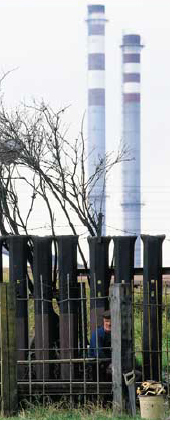
Air pollutant emission changes
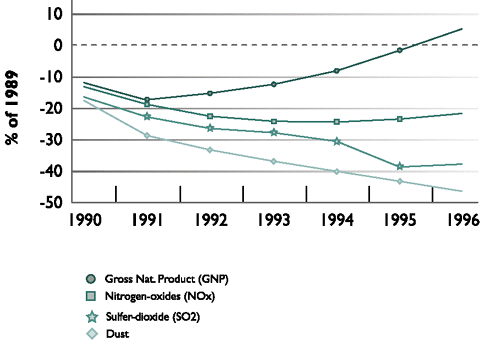
Pollutant emission changes in 1989 to 1996 against the GNP (in percentage of 1989 figures) Agenda 21 in Poland, Progress Report 1992-98, MoE, 1998
Geothermal energy causes almost no pollution in terms of particulate matter, sulphur dioxide, nitrogen oxides or aromatic hydrocarbons. Moreover, geothermal energy provides an additional advantage stemming from the fact that it produces almost no carbon oxide. In other words, there are plenty of environmentally sensible reasons to support the development of geothermal resources.
A better air quality
Even though Poland still relies mainly on the use of coal and coke in its energy production, the emissions of the main air pollutants, sulphur dioxide, nitrogen oxide and particulates, are actually declining or stabilising according to the balances for the period up to 1997.
Initially, the decrease in pollutant emission was a result of the economic recession, where the steady increase in GNP since 1992 has been accompanied by continued reductions in the total pollutant emissions.
Waste water treatment and gypsum handling at Dolna Odra Power Plant
The dependence on coal has lead to serious air pollution problems in Poland but the coal-fired power plants are also a major potential air pollution source. DANCEE has supported a number of projects at the Dolna Odra Power Plant with the overall objective to reduce the air pollution from the existing power plants.
Today, nearly 80 per cent of the energy used in district heating is generated by coal and cokefired power plants - electric power generation is almost entirely based on coal. The effect of coal burning on the pollution of the air and water is well known, and extensively documented.
The problems arise when the sulphur and nitrogen oxides, formed during coal combustion, react in moist air to form sulphuric and nitric acids. These acids, which are spread with the rain, damage the environment and the nature.
The Dolna Odra Power Plant Complex is situated in the north-western part of Poland, 35 kms south of the city of Szczecin near the river Oder and close to the German border. The coal-fired power plant is with its 8x200 MW boiler units one of the largest power plants in Poland and at the same time a major potential source for air pollution close to Denmark.
The objective:
The overall objective of the present project is to reduce the air pollution from the existing power plants. This is going to happen via the establishing of a gypsum handling system and a waste water treatment plant in connection with the extension of a flue gas desulphurisation system (FGD).
The procedure:
The gypsum handling technology is specifically Danish know-how and this project consists of a complete modern plant to handle gypsum of a saleable quality. As an added value to the environmental advantages this technology will also create a new field of export potential to for instance the cement industry in Sweden or Germany.
The waste water treatment plant project comprises a plant for complete purification of the waste water produced in the FGD plant.
The plant is designed for two FGD plants for totally 4x200 MW boilers. The maximum gypsum produced for four boiler units is approximately 22 tonnes per hour corresponding to 160 - 180,000 t/year.
In the waste water treatment plant the heavy metals are precipitated by means of chemicals. In this process the pH-value is adjusted to the optimum value for precipitating heavy metals and later the purified water is discharged to the recipients. The system further separates the solids from the liquid by means of centrifuges.
The filter cake consists of 96 per cent gypsum, while approximately 4 per cent is fly ash containing heavy metals. This filter cake will be returned to the boilers with the coal and hereafter primarily entrapped in the boiler slag and the fly ash. The heavy metals are here entrapped to such an extent that the slag and fly ash can be used as for instance road filler without danger to the groundwater.
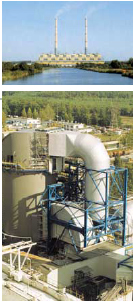
Desulphurisation plant for reducing SO2 emissions
The result:
The entire flue gas desulphurisation plant, the FGD plant, including the projects mentioned was put in operation by the end of 1999. The environmental projects have resulted in a reduction of discharge of SO2 by 30,000 t/y.
The projects secure that the quality of the gypsum will be maintained all the way through to the end users. In addition to the economic advantage of selling the gypsum, the environmental benefits of avoiding to deposit significant amounts of gypsum every year in the surrounding nature will be achieved.
Exploitation of Geothermal EnergyIn Poland, an attractive alternative to coal is available in the form of indigenous geothermal energy. This provides a cost-effective alternative to other low-polluting fuels such as natural gas. Compared to natural gas, Poland has significant geothermal resources. One of the areas in Poland in which geothermal resources are thought to be commercially exploitable is the mountainous Podhale region, where more than 30 per cent of the inhabitants now are connected to the pilot energy plant; this means a particularly efficient air pollution reduction.
Geothermal energy produces almost no pollution in terms of particulate matter, sulphur dioxide, nitrogen oxides, or aromatic hydrocarbons. It has the additional advantage, compared with natural gas that it produces almost no carbon oxides.
Podhale region in the south of the country is one of the areas in Poland in which geothermal resources are thought to be commercially exploitable. The reservoir is an aquifer located at a depth of 2,500-3,200 m in highly fractured limestone and dolomite. Preliminary estimates suggest that there are sufficient geothermal resources to supply heat and hot water for 100 years. Podhale is probably also the country's most popular tourist region, with over 2.5 million visitors recorded annually. The region has great scenic beauty and is characterised by the high mountains of the Tatra range, and extensive forests, lakes and rivers. In addition, the region contains Poland's premier ski resort, at Zakopane, and is of ecological importance because of its calcareous mountainous ecosystems. At present, there are four national parks in the Podhale region.
The economic growth of the region, as a result of the tourism development, has meant a growing demand for heat and energy. At present, coke, coal and natural gas supplies account for about 70% of the total heat demand. The result is that the air quality in resort towns such as Zakopane is now considerably worse than allowed by both national and EU standards. Atmospheric pollution is also beginning to threaten the tourist potential and the unique wildlife of the national parks.
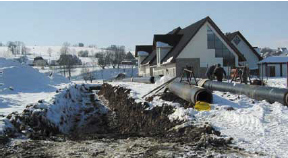

The objective:
Apart from the considerable environmental advantages of geothermal energy there are likely to be long-term cost advantages as well. Polish government policy supports the use of renewable energy resources as a means of achieving higher air quality standards. In this context, it is planned that subsidies will be progressively removed from traditional fuels, which will make geothermal energy a cost-effective alternative to coal in the future. An additional cost advantage of geothermal energy is that it can be distributed through the existing district heating networks, which means that there is limited need for major infrastructure investments.
DANCEE has supported and assisted in the planning, design and start-up and development of two geothermal energy projects in Poland. One is in the Podhale region which is described underneath, and the other in the north-western part of Poland, the Pyrzyce region near Szczecin.
The procedure:
Danish and Dutch technical assistance have helped with the market study, the Podhale project concept, the preliminary design and cost estimates. Feasibility studies were prepared by Danish consultants.
Public participation was also an important part of preparing the project. This involved consultation with intermediary non-governmental organisations, such as the Polish Ecological Club (Polski Klub Ekologiczny) and academic institutions. The municipalities organised public hearings to inform consumers about the economic and environmental advantages of geothermal energy.
The result:
At present more than 30% of the inhabitants are connected. It is expected that the Podhale Geothermy in late 2001 will supply half of Zakopane's inhabitants with an environmentally sustainable heating supply from this underground water and within the next 2 years 80% will be connected. The result of the pilot study showed that the consumers were satisfied with the temperature of the water supplied by geothermal energy, that there was a willingness to convert to geothermal heating, and that consumers paid their bills on time.
Recently, the project received a World Bank loan of USD 38 million and a GEF-grant of USD 5,4 million for particularly efficient CO2 reducing initiatives. This financing as well as an additional USD 8 million from PHARE makes it possible to complete the project and to cover the entire Podhale valley.
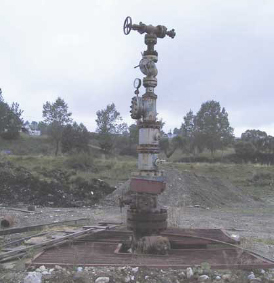
Geothermal heat is heat produced in the waterbearing aquifers in the underground as a result of heat from the earth rising towards the surface. The heat is produced by drilling wells to these layers and pumping the water through a geothermal production plant where the heat is conveyed to a district heating system by means of direct heat exchange and in some cases also heating pumps. The cooled water is then led back to the same water-bearing aquifer by means of injection wells. The locations, which are most appropriate for such technique, are locations with a considerable district heating system with low temperature level and having an underground with suitable water-bearing layers i.e. a thick sand layer. Such layers are typically found at 1-3 km depth containing 30-100 degrees C hot water